AleaSoft, November 12, 2020. The European electricity markets prices rose in a generalised way in the first days of the second week of November, continuing the trend of the first week of the month. Again the increase in demand and the decrease in wind energy production were the fundamental factors behind the decline. The Brent and CO2 futures also recovered and reached values not seen since the second half of September and the first of October, respectively.
Photovoltaic and solar thermal energy production and wind energy production
During the first three days of the week starting on Monday, November 9, the average solar energy production decreased by 49% in the German market compared to the average of the previous week. On the contrary, in the Iberian Peninsula, the production increased by 57%, while in the Italian and French markets, the production growth was 12% and 1.6% respectively.
During the first 11 days of November, the solar energy production increased in all the markets analysed at AleaSoft. In the Iberian Peninsula, the production grew by 35% compared to the same days of 2019 and in the markets of France and Italy the increases were 49% in both cases. Similarly, 45% more was produced with this technology in the German market.
The analysis carried out at AleaSoft indicates that at the end of the week of November 9, the solar energy production in the markets of Germany and Italy will be lower than that of the previous week.
 Source: Prepared by AleaSoft using data from ENTSO-E, RTE, REN, REE and TERNA.
Source: Prepared by AleaSoft using data from ENTSO-E, RTE, REN, REE and TERNA.
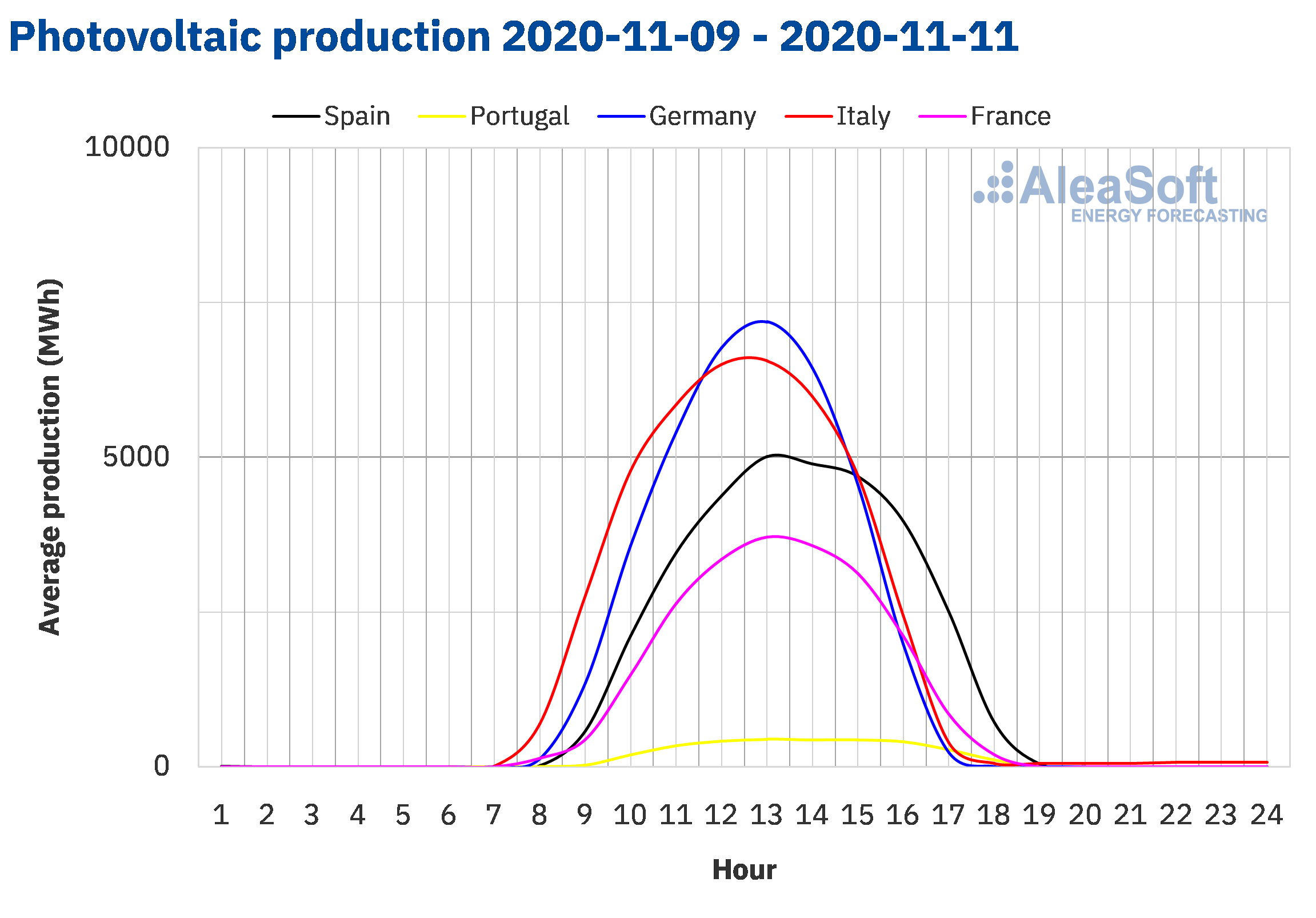 Source: Prepared by AleaSoft using data from ENTSO-E, RTE, REN, REE and TERNA.
Source: Prepared by AleaSoft using data from ENTSO-E, RTE, REN, REE and TERNA.
The average wind energy production in the first three days of the second week of November decreased in all the markets analysed at AleaSoft compared to the average registered the previous week. In the German market, the production with this technology reduced by 77%, while in the Iberian Peninsula and in the French market it fell by 64% and 62% respectively. In the Italian market, the drop in wind energy production was 30%.
In the year‑on‑year analysis, during the first 11 days of November, the production with this technology increased by 3.9% in the German market. In the rest of the analysed markets, the production decreased. The most prominent case is the Italian market in which the production fell by 74%.
The AleaSoft‘s analysis indicates that at the end of the second week of November, the total wind energy production of the week will continue to be lower than that registered during the week of November 2 in all the markets analysed at AleaSoft.
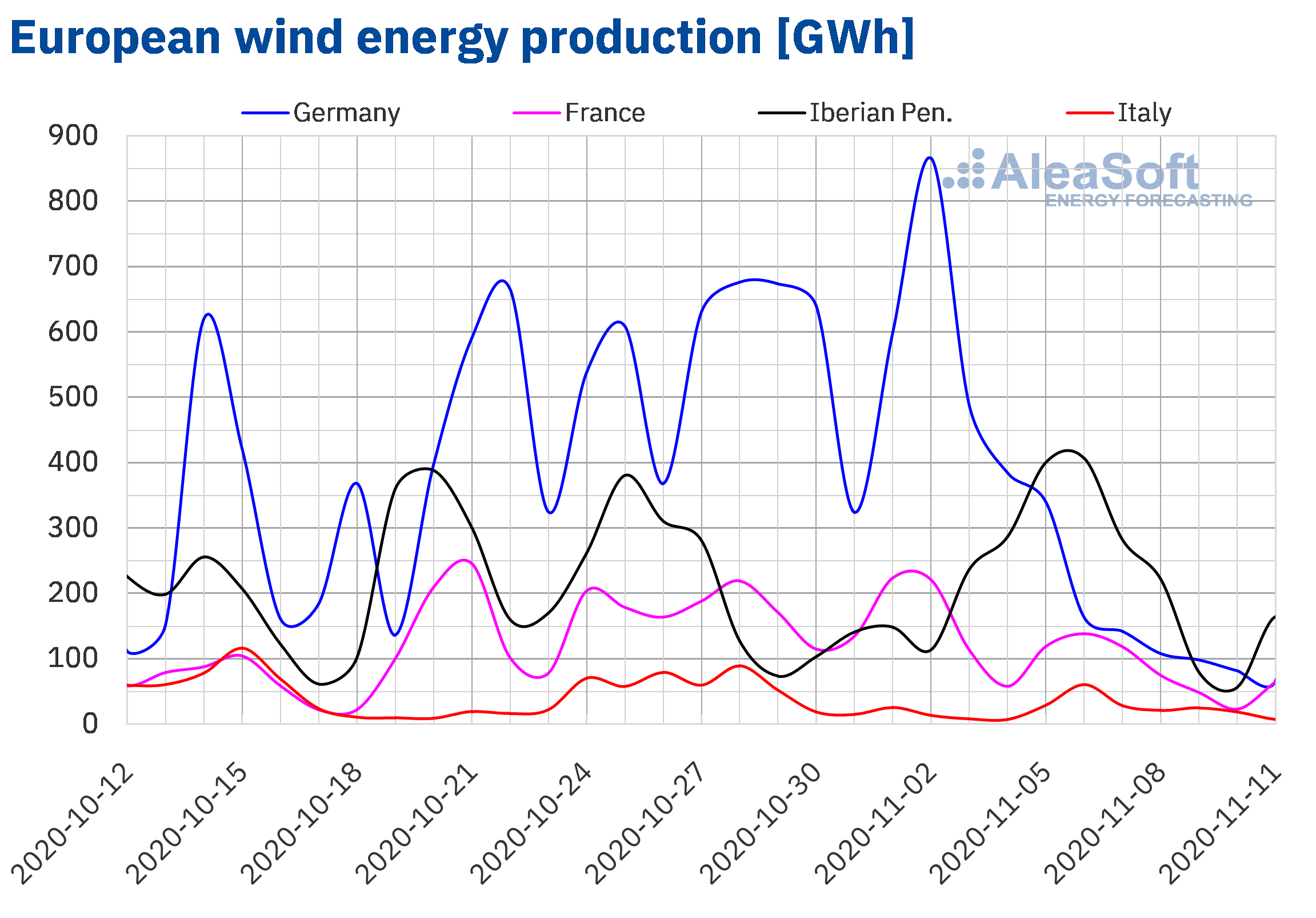 Source: Prepared by AleaSoft using data from ENTSO-E, RTE, REN, REE and TERNA.
Source: Prepared by AleaSoft using data from ENTSO-E, RTE, REN, REE and TERNA.
Electricity demand
The electricity demand continued the rise of the week of November 2 in most European markets, increasing between Monday and Wednesday of the week of November 9 compared to the same period of the previous week. In the markets of Germany and Portugal, the demand increased by 1.7% and 1.4% respectively, while in Italy and Belgium the increases were 0.8% and 0.7%. In the case of the French market, a 4.9% decrease was registered, influenced by the effect of the holiday of November 11, Armistice Day. Once the effect of this holiday was corrected, the decrease was 1, 4%.
For the final calculation of the second week of November, the AleaSoft‘s demand forecasting indicates that each market will maintain the trend registered during the first three days of the week. However, the demand could be affected by the effect of the restrictions implemented to slow the spread of the coronavirus in various European countries.
 Source: Prepared by AleaSoft using data from ENTSO-E, RTE, REN, REE, TERNA, National Grid and ELIA.
Source: Prepared by AleaSoft using data from ENTSO-E, RTE, REN, REE, TERNA, National Grid and ELIA.
Mainland Spain, photovoltaic and solar thermal energy production and wind energy production
In Mainland Spain, there was an increase in electricity demand of 2.6% during the first three days of the week compared to the same days of the first week of November. One of the influencing factors in this rise was the All Saints Day holiday celebrated on November 2 in six autonomous communities. When correcting this effect and that of the November 9 holiday in Madrid, the rise was 0.6%. At AleaSoft, it is expected that the total demand of the week of November 9 will be higher than that of the previous week.
The average solar energy production of Mainland Spain, which includes the photovoltaic and solar thermal technologies, increased by 57% between Monday and Wednesday of the week that began on November 9 compared to the average of the previous week. In the year‑on‑year comparison, the production with these technologies during the first 11 days of November registered an increase of 36%. At the end of the second week of the month, at AleaSoft the total solar energy production is expected to be higher than that registered during the previous week.
The average level of the wind energy production in Mainland Spain of the first three days of the week of November 9, decreased by 61% compared to the average of the previous week. In the year‑on‑year analysis, the production registered during the first 11 days of November was 40% lower. According to the analysis carried out at AleaSoft, for the week of November 9 to 15, it is expected that the production with this technology will continue to be lower than that registered during the week that ended on Sunday, November 8.
The nuclear energy production remains with a daily average close to 146 GWh. The unit II of the Ascó nuclear power plant continues to be disconnected from the grid due to a scheduled shutdown, since Saturday, October 3. According to ENTSO‑E, the plant will go back into operation on November 16.
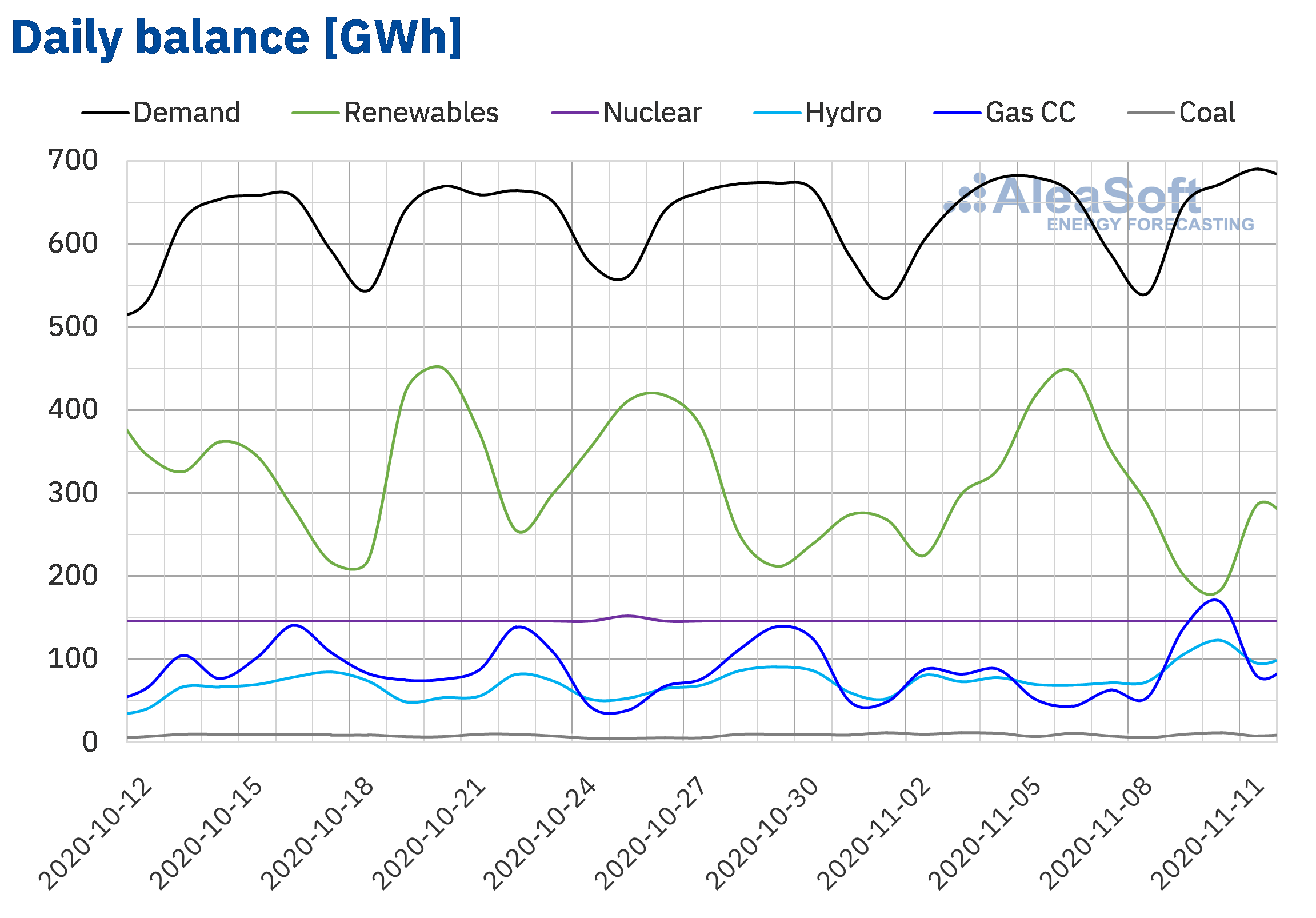 Sources: Prepared by AleaSoft using data from REE.
Sources: Prepared by AleaSoft using data from REE.
The hydroelectric reserves currently have 10 698 GWh stored, according to data from the Hydrological Bulletin of the Ministry for Ecological Transition and Demographic Challenge number 45, which represents an increase of 140 GWh compared to bulletin number 44.
European electricity markets
The first four days of the week of November 9, the prices increased in all the European electricity markets analysed at AleaSoft compared to the same period of the previous week. The largest price rise, of 103%, was that of the Nord Pool market of the Nordic countries, followed by the 30% increase of the EPEX SPOT market of Germany. In contrast, the N2EX market of Great Britain and the IPEX market of Italy had the lowest price increases, of 4.8% and 14% respectively. In the rest of the markets, the price increases were between 18% of the EPEX SPOT market of France and 22% of the EPEX SPOT markets of Belgium and the Netherlands.
During the first four days of the second week of November, the market with the lowest average price, of €8.85/MWh, was the Nord Pool market of the Nordic countries. On the other hand, the highest average price in this period, of €50.53/MWh, was that of the Italian market, followed by that of the British market, of €50.30/MWh. The averages for the rest of the markets were between €42.71/MWh of the French market and €46.23/MWh of the MIBEL market of Spain.
In the first four days of the second week of November, the Nord Pool market had the lowest daily prices, more than €30/MWh lower than those of the rest of the markets. On Monday, the prices of the rest of the markets were quite coupled, except those of the British market, which were higher. But, as of Tuesday, the coupling was decreasing.
Between November 9 and 12, the daily prices exceeded €50/MWh at specific cases in the MIBEL market of Spain and Portugal, in the Italian market and in the British market. The highest daily price was that of Thursday, November 12, in the Italian market, of €57.86/MWh. On the other hand, the daily prices of the Nord Pool market remained below €11/MWh. The lowest daily price, of €7.07/MWh, was also reached on Thursday in this market.
Regarding the hourly prices, the first four days of the week of November 9, there were no negative hourly prices in the analysed European electricity markets. On the other hand, the highest hourly price of the first four days of the second week of November, of €93.66/MWh, was reached at the hour 19 of Tuesday, November 10, in the British market.
 Source: Prepared by AleaSoft using data from OMIE, EPEX SPOT, N2EX, IPEX and Nord Pool.
Source: Prepared by AleaSoft using data from OMIE, EPEX SPOT, N2EX, IPEX and Nord Pool.
The general decrease in wind energy production and the increase in demand in most markets favoured the price increases during the first days of the week of November 9. In addition, in the case of Germany, the solar energy production also fell, contributing to this being the market with the second largest price increase.
The AleaSoft‘s price forecasting indicates that at the end of the second week of November the average prices will be higher than those registered during the week of November 2 in all European markets. On the other hand, it is expected that during the week of November 16, the recovery in wind energy production will favour the decrease in prices in most of these markets.
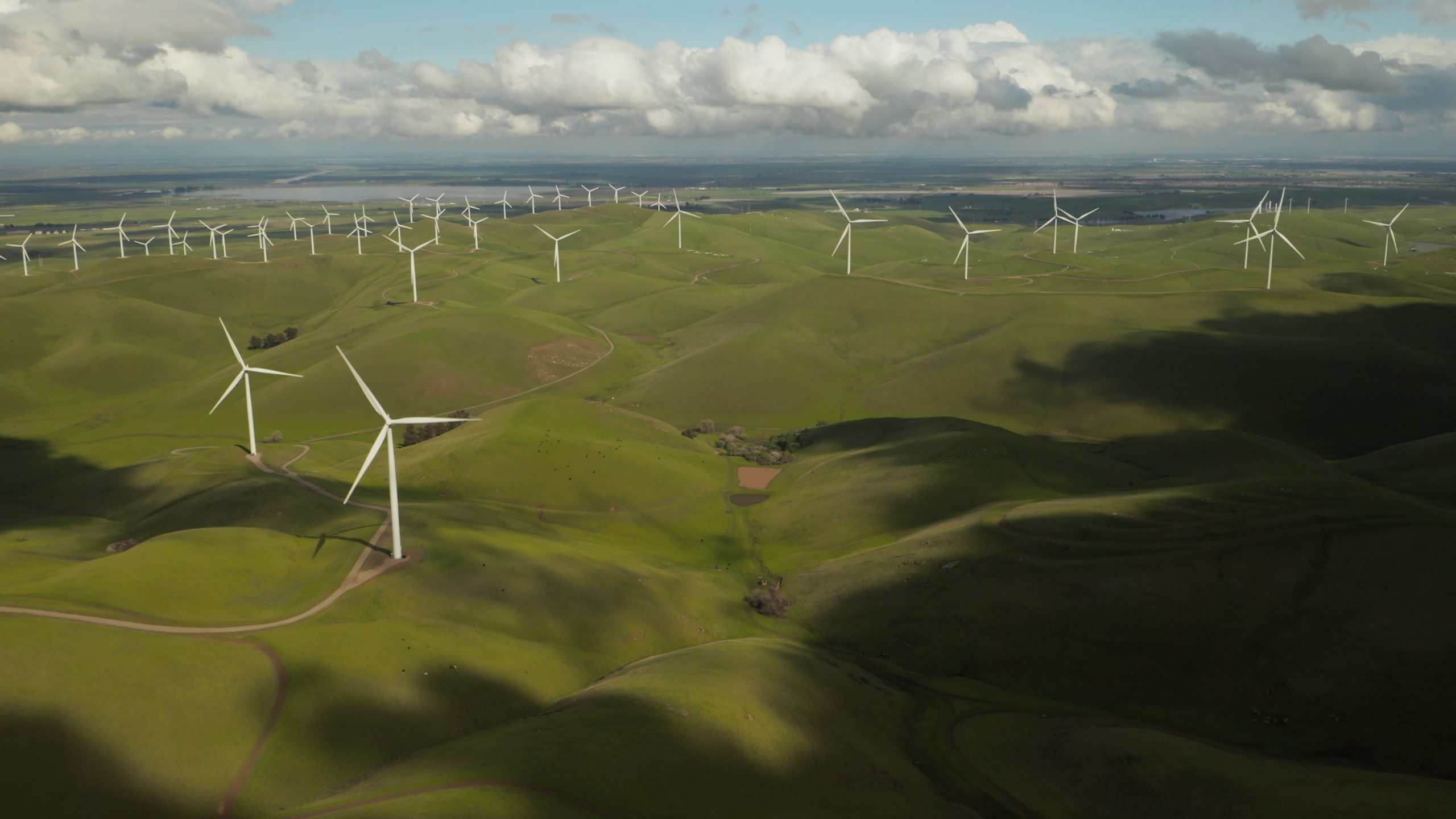
Iberian market
In the MIBEL market of Spain and Portugal, the average price of the first four days of the week of November 9 increased compared to the same period of the previous week. The increase was 21% in both Spain and Portugal.
Due to this price increase, the average price from November 9 to 12 was €46.23/MWh in the Spanish market and €46.22/MWh in the Portuguese market. These were the third and fourth highest prices in the European markets, after those registered by the markets of Italy and Great Britain.
Regarding the daily prices of the MIBEL market of the first four days of the second week of November, the maximum daily price, of €50.67/MWh, was reached on Tuesday, November 10, in the Spanish market. The rest of the days, the prices were the same in both Spain and Portugal and remained below €50/MWh. The minimum daily price, of €43.30/MWh, was reached on Wednesday, November 11.
During the first days of the week of November 9, the increase in demand in Spain and Portugal and the fall in wind energy production in the Iberian Peninsula favoured the increase in prices in the MIBEL market.
However, the AleaSoft‘s price forecasting indicates that for the third week of November the wind energy production will recover, allowing the MIBEL market prices to fall.
Electricity futures
During the first three days of the second week of November, the electricity futures prices for the first quarter of 2021 had heterogeneous behaviours in the European markets analysed at AleaSoft. On the one hand, in the EEX market of Germany and France, the ICE market of Belgium and the Nordic countries and the NASDAQ market of the latter region, the prices decreased compared to those of the session of Friday, November 6. The markets of the Nordic countries were the leaders in these declines, with falls close to 17%. On the other hand, in the EEX markets of Spain, Italy and Great Britain, OMIP of Spain and Portugal and ICE of Great Britain and the Netherlands, the prices increased, with the OMIP market being the one with the highest increase, of 1.3% for both countries. The ICE market of Great Britain was the one with the lowest variation in absolute terms, with an increase of €0.11/MWh.
As for the electricity futures prices for the year 2021, the behaviour of the markets was mostly downward. The exceptions were the ICE markets of Great Britain and the Netherlands, where the prices increased by 1.0% in both cases. As for the declines, the prices of the markets of the Nordic region fell by 30%. In the rest of the markets, the prices fell between 1.3% of the ICE market of Belgium and 5.7% of the EEX market of France.

Brent, fuels and CO2
The Brent oil futures prices for the month of January 2021 in the ICE market, the first three days of the week of November 9, began an upward trend. As a result, the settlement price of Wednesday, November 11, was $43.80/bbl, 6.2% higher than that of the previous Wednesday and the highest since the beginning of the second half of September.
The news about a vaccine capable of protecting against COVID‑19 infections in 90% of cases, favoured the price increases of the first days of the second week of November. The US election results also contributed to these increases.
However, the last forecasting made by the OPEC and published on Wednesday on the crude oil demand fell compared to those made a month ago, due to the new measures implemented to contain the coronavirus. This will make it necessary to reconsider the production increases planned for January at the next OPEC+ meeting, which is to be held at the end of November. Meanwhile, the statements regarding the intentions on this issue by OPEC+ member countries are expected to influence the price evolution.
On the other hand, the TTF gas futures in the ICE market for the month of December 2020, started the week with a settlement price of €13.85/MWh on Monday, November 9. This price was 0.3% lower than that of the last session of the previous week. However, in the two following days there were price increases. On Wednesday, November 11, the settlement price was €14.10/MWh, 1.5% higher than that of the same day of the previous week.
Regarding the TTF gas in the spot market, the first four days of the second week of November, the prices increased. As a result, the index price of Thursday, November 12, was €14.10/MWh.
As for the API 2 coal futures in the ICE market for the month of December 2020, on Monday, November 9, they registered a settlement price of $51.25/t, which was the lowest since the end of August. But a price recovery began on Tuesday. On Wednesday, November 11, a settlement price of $52.65/t was reached, 2.3% higher than that of the previous Wednesday and the highest of the first 11 days of November.
Regarding the CO2 emission rights futures in the EEX market for the reference contract of December 2020, on Monday, November 9, a settlement price of €26.55/t was reached. This price was 12% higher than that of the previous Monday and the highest since the first half of October. But on Tuesday the prices began to fall and on Wednesday a settlement price of €26.13/t was registered. However, this price was still 4.1% higher than that of the previous Wednesday.
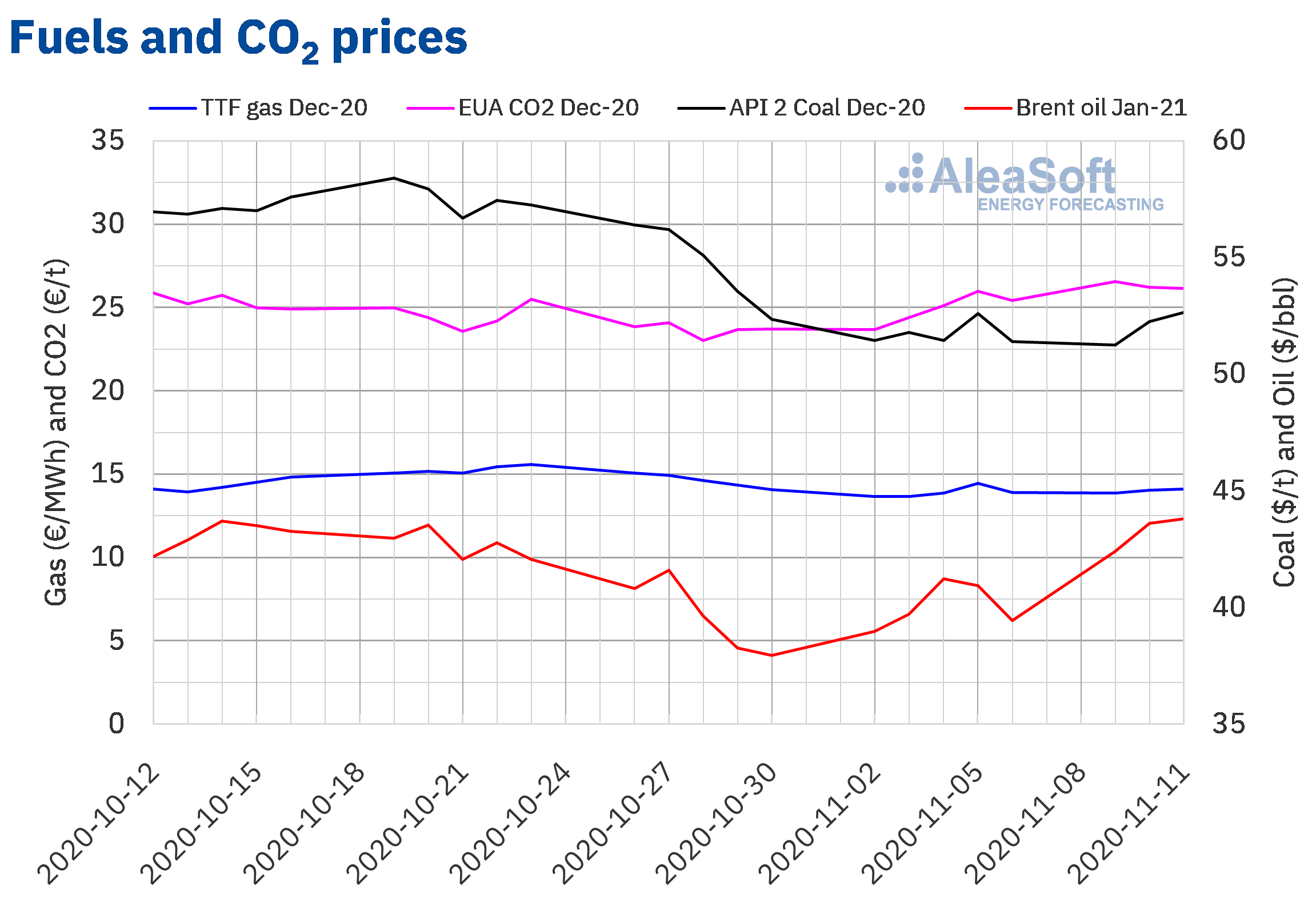 Source: Prepared by AleaSoft using data from ICE and EEX.
Source: Prepared by AleaSoft using data from ICE and EEX.
AleaSoft analysis of the evolution of the energy markets and prospects from 2021
At AleaSoft, its last webinar of the year 2020 is being organised, which will be held on November 26 and will be entitled “Prospects for the energy markets in Europe from 2021 (I)”. As its name indicates, this time the analysis of the topics will focus on the prospects from 2021, after a year 2020 marked by the COVID‑19 pandemic that caused a deep global economic crisis. In addition to addressing the evolution of the energy markets, the new system of renewable energy auctions proposed by the Spanish Government and its effect on the market will be analysed, as well as the technical Due Diligence and its importance in the projects financing. To talk about all these topics, there will also be the participation of three speakers from Vector Renewables.
When defining an energy purchase strategy, either through a supply contract with a retailer, a PPA or directly in the markets, it is essential to have mid‑term forecasting with probability distributions that help to minimise the market prices risk. AleaSoft has this type of forecasting for the main European electricity markets, which are updated every month taking into account the evolution of the markets and the economy, as well as the prospects for the recovery from the economic crisis.
At the AleaSoft‘s markets observatories, the energy markets can be monitored during the last weeks, which allows analysing whether they were affected during the second wave of COVID‑19. The observatories include comparative graphs with the main variables of the European electricity, gas, oil and CO2 markets, whose data is updated daily.
Source: AleaSoft Energy Forecasting.
